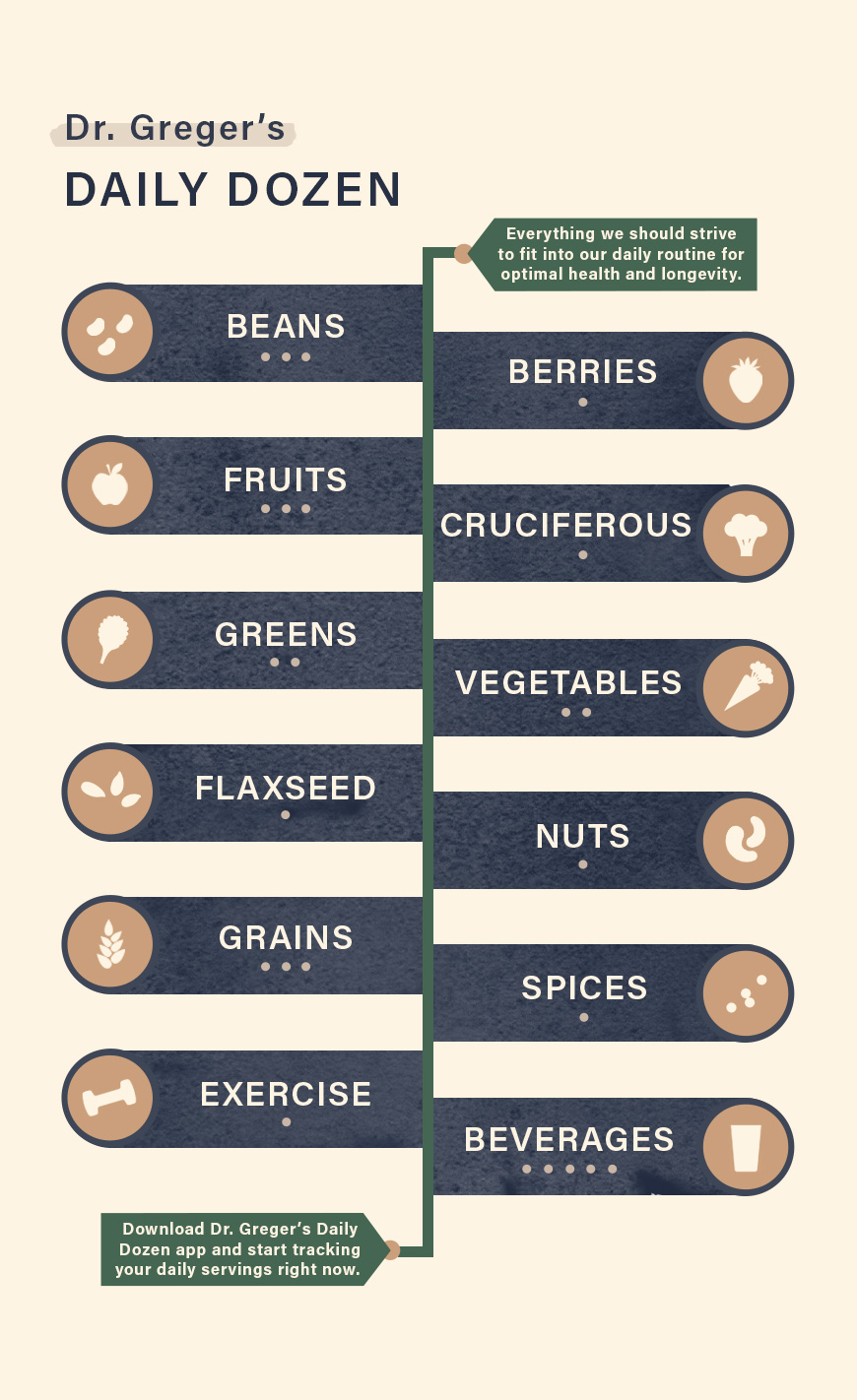
February 09, 2020 at 06:00PM by CWC
When a wellness goal of eating healthy reaches a point where it’s totally stressing you out, it’s pretty much counterproductive. (We all know how bad stress is, right?) But it makes sense why so many people get burned out trying to figure out what to eat and live a healthy lifestyle: Comparing different eating plans, carving out time to meal prep, and Googling healthy recipes can all become tedious. Why does eating well feel like so much work?
Michael Greger, MD, gets it. He regularly hears from patients how confused they are about what to eat. Dr. Greger is all about eating for optimal health and longevity, but he is against dieting, which is restrictive and only beneficial in the short-term (if at all). He’s so passionate about it that he actually just released a book aptly called, How Not To Diet.
Not dieting is cool and all, but there’s still the question of what to eat. Ever the resourceful MD, Dr. Greger has a handy cheat sheet for that, what he calls the Daily Dozen. The Daily Dozen is a checklist of 12 science-backed healthy lifestyle and eating tips tied to longevity. The intention isn’t for it to be another list of rules to adhere to; it’s meant to simplify healthy eating.
How to use Dr. Gregor’s Daily Dozen checklist for easier, healthier living

1. Eat 3 servings of beans
ADVERTISEMENT
ADVERTISEMENTKate Spade Autumn/Winter Sale |
Dr. Greger’s first tip is inspired straight from Blue Zones, places in the world where people regularly live to be over 100. “All Blue Zones inhabitants include legumes in their diet,” he says. Legumes are longevity-boosting powerhouses because they are loaded with protein, iron, and zinc, much like other protein sources such as meat. Unlike meat, they’re also are free of saturated fat and cholesterol.
“What’s more, legumes also contain nutrients that are concentrated in the vegetable kingdom, like fiber, folate, and potassium,” he says. BTW, loading up on chickpeas can help you reach the three servings goal.
2. Eat 1 serving of berries
There’s a reason why Dr. Greger singles out berries (although you’ll see, it doesn’t mean you should ignore all other fruit). “Harvard researchers found that women who consumed at least one serving of blueberries and two servings of strawberries each week had slower rates of cognitive decline—by as much as two and a half years—compared with those who didn’t eat berries. It’s amazing!” he says. “Simply eating a handful of berries every day, one easy and delicious dietary tweak, may slow your brain’s aging by more than two years.”
As if being literal brain food wasn’t enough, Dr. Greger adds that an American Cancer Society study found that those who ate the most berries appeared significantly less likely to die of cardiovascular disease.
Watch the video to see how to make a healthy blueberry pie:
3. Eat 3 servings of other fruit
“It took years for nearly 500 researchers from more than 300 institutions in 50 countries to develop the 2010 Global Burden of Disease study, the largest analysis of risk factors for death and disease in history. In the U.S., the massive study determined that the leading cause of both death and disability was the American diet, followed by smoking. What did they determine to be the worst aspect about our diet? Not eating enough fruit,” Dr. Greger says. It sounds like there’s something to the whole “apple a day” adage after all.
4. Eat 2 servings of greens
Just like berries are the healthiest fruit, Dr. Greger says greens are the healthiest type of vegetable. “In fact, greens are the healthiest food period,” he declares. The reason why they’re so vital to healthy living, Dr. Greger says, is because greens pack more nutrients per calorie than any other food. “Each daily serving translates to about a 20 percent drop in heart attack and stroke risk,” he says. Suddenly that salad doesn’t look so sad, am I right?
5. Eat 1 serving of cruciferous vegetables
“Greens are the healthiest foods, and the healthiest kind of greens are cruciferous vegetables,” Dr. Greger says. He’s talking about broccoli, kale, collard greens, and cabbage, to name some biggies. Some research links a diet rich in cruciferous vegetables to a reduced risk of certain types of cancer.
“My family always keeps a purple cabbage—which has the same kind of eyesight- and brain-protecting antioxidants that berries do at a fraction of the cost—in the crisper so we can slice off shreds onto any meal for a colorful, health-promoting garnish,” Dr. Greger says.
6. Eat 2 servings of other vegetables
While greens are Dr. Greger’s top recommended veggie, he’s certainly still into the others, too. You know that aforementioned Global Burden of Disease study he mentioned? Researchers also found that inadequate vegetable intake was the fifth-leading dietary risk factor for disability and death in the U.S. Just another reason to be thankful for the metamorphosing powers of cauliflower and broccoli.
7. Eat 1 serving of flaxseed
Flaxseed is the wild card of the Daily Dozen, making Dr. Greger’s list because they’re the single most concentrated source of lignans, which are a type of anti-cancer compound. They’re also a great way to up your omega-3 intake, especially if you don’t eat fish.
ADVERTISEMENT
ADVERTISEMENTSports Direct Free Delivery on All Orders! |
8. Eat 1 serving of nuts and seeds
Snacking on nuts and seeds is a major longevity-booster. “Adding just a small palmful of nuts to one’s daily diet for a few years can cut your risk of having a stroke in half,” Dr. Greger says.
9. Eat 3 servings of whole grains
“We should get the bulk of our energy from whole grains,” Dr. Greger says plainly. “People who eat more whole grains—like oatmeal, brown rice, and whole wheat—have been shown to live significantly longer, due to lower rates of heart disease, obesity , diabetes, and stroke.” Plus, they’re rich in gut health-promoting fiber and other phytonutrients.
10. Eat 1 serving of herbs and spices
Dr. Greger’s number one recommended spice is (not shockingly) turmeric. “More than 50 clinical trials have tested turmeric against a variety of diseases, including those of the lungs and brain, and a number of cancers,” he says. It’s an inflammation superstar to say the least. Other herbs and spices he loves: cumin, ginger, chili powder, ginger, and garlic.
Curious about the health benefits of garlic? Check out the video below:
11. Exercise (90 minutes moderate or 40 minutes vigorous activity)
It may sound like common sense, but sometimes the focus of a healthy lifestyle is so much on food, it’s easy to forget that physical activity is important, too. Besides helping to maintain a healthy weight, Dr. Greger points out that regular exercise is also connected to brain and immune heath, as well as better sleep. (It’s a tentpole of Blue Zones living for a reason.)
12. Drink 5 servings of water
Thought hydration would be left out of a healthy lifestyle hit list? Never! “The Beverage Guidance Panel was assembled to provide recommendations on the health and nutritional benefits and risks of various beverages,” Dr. Greger says. “Tea and coffee—preferably without creamer or sweetener—tied as the number-two healthiest beverages, second only to water, the top-ranked drink.” Not only is staying hydrated good for your skin, your body also needs it to function properly; you literally can’t live without it!
Here are some more Blue Zone-backed tips on how to live longer, including the five habits that matter most.
Author Emily Laurence | Well and Good
Selected by CWC

ADVERTISEMENT
ADVERTISEMENTUp to 30% off Gift Sets |







